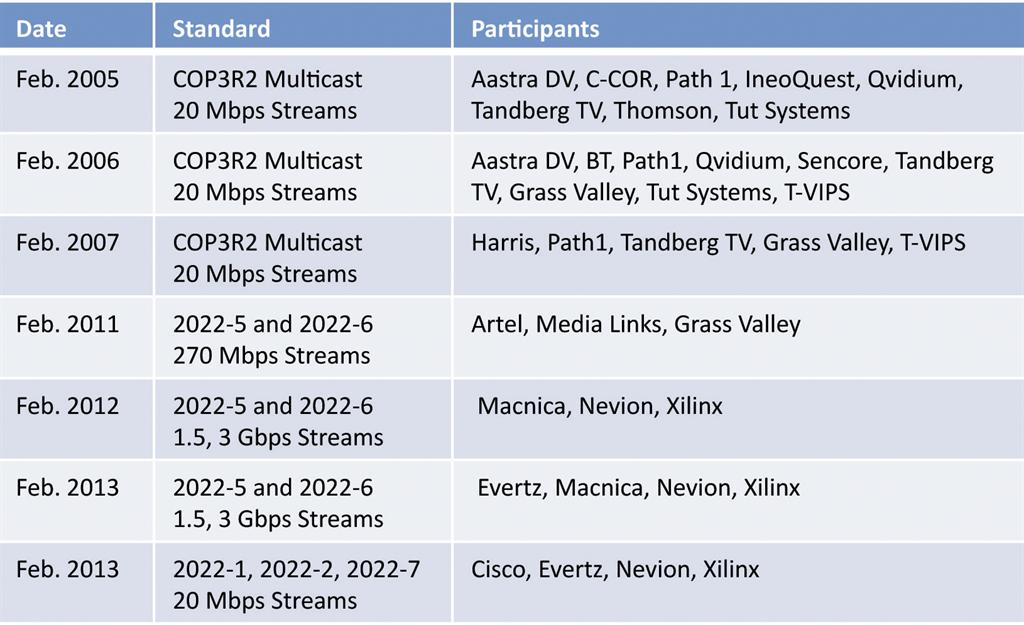SMPTE 2022 and the Future of Video Over IP
As broadcasters migrate towards IP networks for video transport both outside and inside the studio, many existing, proprietary systems are being phased out in favor of products that offer interoperability based on standards.
First introduced in 2007, the SMPTE 2022 standard has since expanded to cover more types of IP video transport. The first two sections of the standard cover IP protocols for compressed, constant bit-rate video signals in MPEG-2 transport streams, based on COP3 from the Pro MPEG Forum. Newer sections of the standard cover two different kinds of variable-rate compressed video signals, as well as methods for carrying uncompressed video and hitless protection switching. Each section of 2022 is described below.
ST 2022-1:2007 “Forward Error Correction for Real-Time Video/Audio Transport Over IP Networks” defines row/column FEC (Forward Error Correction) for IP video streams. Along with Section 2, this standard has been widely implemented. Row/Column FEC works by grouping IP video packets into logical rows and columns, and then appending one FEC packet to each row and each column.

Fig. 1: SMPTE 2022 interoperability tests conducted by the Video Services Forum In the event that one packet is lost from a row or a column, the data in that packet can be perfectly recreated using the contents of the FEC packet in conjunction with the other packets in the row or column. This method works quite well, and allows the packet stream to survive lengthy bursts of lost packets.
ST 2022-2:2007 “Unidirectional Transport of Constant Bit Rate MPEG-2 Transport Streams on IP Networks” specifies how constant bit rate compressed video signals that are encoded within MPEG-2 transport streams are encapsulated into IP packets. This standard covers the transport layer (RTP and UDP) as well as comments about timing and buffer sizes.
ST 2022-3:2010 “Unidirectional Transport of Variable Bit Rate MPEG-2 Transport Streams on IP Networks” defines IP packets for variable bit-rate MPEG-2 TS streams that are constrained to have a constant bit rate between PCR messages (called piecewise-constant).
ST 2022-4:2011 “Unidirectional Transport of Non-Piecewise Constant Variable Bit Rate MPEG-2 Streams on IP Networks” is similar to Section 3, except that it removes the constraint on bit rates.
ST 2022-5:2012 “Forward Error Correction for High Bit Rate Media Transport Over IP Networks” expands on Section 1 to allow larger row/column FEC combinations to support signals with bit rates up to 3 Gbps and beyond. A minor revision to this standard is scheduled to be published in 2013 by SMPTE.
ST 2022-6:2012 “Transport of High Bit Rate Media Signals over IP Networks (HBRMT)” specifies a way to transport high bit-rate signals (including uncompressed 3 Gbps 1080p video) that are not encapsulated in MPEG-2 transport streams.
2022-7 (approval pending) “Seamless Protection Switching of SMPTE ST 2022 IP Datagrams” describes a way to send two matching streams of packets from a source to a destination over different paths, and have the receiver switch automatically between them. This allows a perfect video signal to be reconstructed at the receiver as long as both paths do not fail simultaneously.
Another section originally called 2022- 8 was proposed to define a mapping for JPEG2000 over MPEG-2TS over IP with FEC. This capability appears to have been fulfilled by the publication of VSF (Video Services Forum, www.videoservicesforum.org) Technical Recommendation TR- 01 “Transport of JPEG 2000 Broadcast Profile Video in MPEG-2 TS over IP.”
The VSF has also arranged a number of successful interoperability tests (“interops”) to demonstrate that devices from different manufacturers are able to send and receive bit streams to one another. Fig. 1 shows a list of the interoperability tests that have been performed to date.
2022 INSIDE THE STUDIO?
Work is currently underway in the Joint Task Force on Networked Media to map out a strategy for using packet-based networks in the professional media industry. This group, which held its first meeting in March, is a cooperative effort between SMPTE, the VSF and the European Broadcasting Union. SMPTE 2022 may be considered by the task force for encapsulating uncompressed SDI and HD-SDI signals so they can be transported over IP networks within a studio, in place of baseband signals over coaxial cables.
Other standards groups, such as IEEE 1722 Audio Video Transport Protocol, use different methods for encapsulating SDI video, one of which eliminates the RTP headers found in 2022 and maps video into Ethernet frames (packets). IEEE 1722 also dispenses with FEC (since packet loss is very rare within local networks) and groups all of the data associated with each line of video into an integer number of Ethernet frames, potentially making it easier to build devices that perform switching between video signals. Results from the task force are expected to be ready in 2014.
As a wide-ranging standard for IP video, SMPTE 2022 will certainly become more important as IP technology continues to penetrate the professional video production market.
Thanks to Carl Ostrom, Jack Douglass and John Dale (all very active members of the VSF) for providing information that was used in writing this column.
Wes Simpson is an industry consultant and author of “Video Over IP, Second Edition,” from Focal Press. Your comments are welcome towes.simpson@gmail.com.
Get the TV Tech Newsletter
The professional video industry's #1 source for news, trends and product and tech information. Sign up below.
Wes Simpson is President of Telecom Product Consulting, an independent consulting firm that focuses on video and telecommunications products. He has 30 years experience in the design, development and marketing of products for telecommunication applications. He is a frequent speaker at industry events such as IBC, NAB and VidTrans and is author of the book Video Over IP and a frequent contributor to TV Tech. Wes is a founding member of the Video Services Forum.

